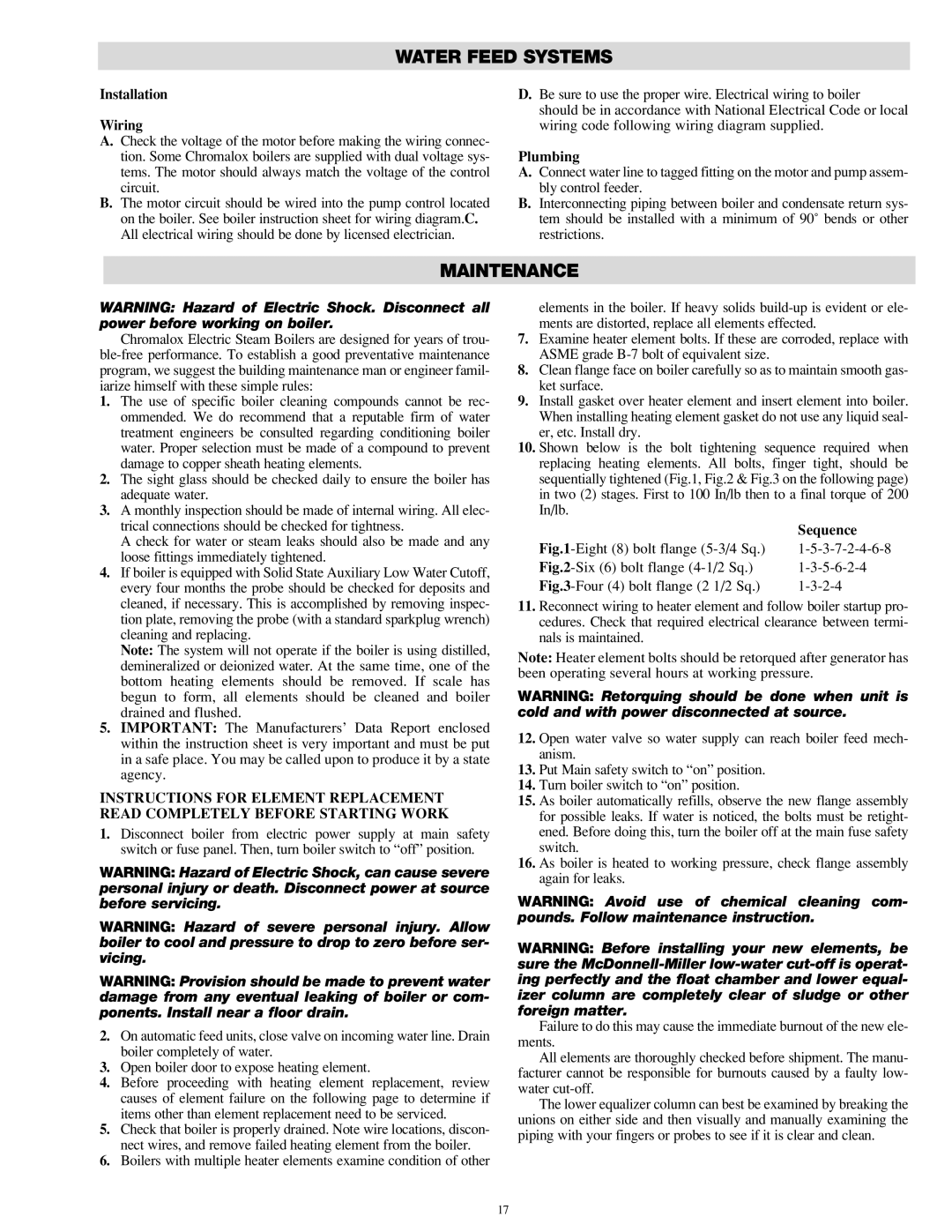WARNING: Hazard of Electric Shock. Disconnect all power before working on boiler.
Chromalox Electric Steam Boilers are designed for years of trou- ble-free performance. To establish a good preventative maintenance program, we suggest the building maintenance man or engineer famil- iarize himself with these simple rules:
1.The use of specific boiler cleaning compounds cannot be rec- ommended. We do recommend that a reputable firm of water treatment engineers be consulted regarding conditioning boiler water. Proper selection must be made of a compound to prevent damage to copper sheath heating elements.
2.The sight glass should be checked daily to ensure the boiler has adequate water.
3.A monthly inspection should be made of internal wiring. All elec- trical connections should be checked for tightness.
A check for water or steam leaks should also be made and any loose fittings immediately tightened.
4.If boiler is equipped with Solid State Auxiliary Low Water Cutoff, every four months the probe should be checked for deposits and cleaned, if necessary. This is accomplished by removing inspec- tion plate, removing the probe (with a standard sparkplug wrench) cleaning and replacing.
Note: The system will not operate if the boiler is using distilled, demineralized or deionized water. At the same time, one of the bottom heating elements should be removed. If scale has begun to form, all elements should be cleaned and boiler drained and flushed.
5.IMPORTANT: The Manufacturers’ Data Report enclosed within the instruction sheet is very important and must be put in a safe place. You may be called upon to produce it by a state agency.
INSTRUCTIONS FOR ELEMENT REPLACEMENT READ COMPLETELY BEFORE STARTING WORK
1.Disconnect boiler from electric power supply at main safety switch or fuse panel. Then, turn boiler switch to “off” position.
WARNING: Hazard of Electric Shock, can cause severe personal injury or death. Disconnect power at source before servicing.
WARNING: Hazard of severe personal injury. Allow boiler to cool and pressure to drop to zero before ser- vicing.
WARNING: Provision should be made to prevent water damage from any eventual leaking of boiler or com- ponents. Install near a floor drain.
2.On automatic feed units, close valve on incoming water line. Drain boiler completely of water.
3.Open boiler door to expose heating element.
4.Before proceeding with heating element replacement, review causes of element failure on the following page to determine if items other than element replacement need to be serviced.
5.Check that boiler is properly drained. Note wire locations, discon- nect wires, and remove failed heating element from the boiler.
6.Boilers with multiple heater elements examine condition of other
elements in the boiler. If heavy solids build-up is evident or ele- ments are distorted, replace all elements effected.
7.Examine heater element bolts. If these are corroded, replace with ASME grade B-7 bolt of equivalent size.
8.Clean flange face on boiler carefully so as to maintain smooth gas- ket surface.
9.Install gasket over heater element and insert element into boiler. When installing heating element gasket do not use any liquid seal- er, etc. Install dry.
10.Shown below is the bolt tightening sequence required when replacing heating elements. All bolts, finger tight, should be sequentially tightened (Fig.1, Fig.2 & Fig.3 on the following page) in two (2) stages. First to 100 In/lb then to a final torque of 200 In/lb.
| Sequence |
Fig.1-Eight (8) bolt flange (5-3/4 Sq.) | 1-5-3-7-2-4-6-8 |
Fig.2-Six (6) bolt flange (4-1/2 Sq.) | 1-3-5-6-2-4 |
Fig.3-Four (4) bolt flange (2 1/2 Sq.) | 1-3-2-4 |
11.Reconnect wiring to heater element and follow boiler startup pro- cedures. Check that required electrical clearance between termi- nals is maintained.
Note: Heater element bolts should be retorqued after generator has been operating several hours at working pressure.
WARNING: Retorquing should be done when unit is cold and with power disconnected at source.
12.Open water valve so water supply can reach boiler feed mech- anism.
13.Put Main safety switch to “on” position.
14.Turn boiler switch to “on” position.
15.As boiler automatically refills, observe the new flange assembly for possible leaks. If water is noticed, the bolts must be retight- ened. Before doing this, turn the boiler off at the main fuse safety switch.
16.As boiler is heated to working pressure, check flange assembly again for leaks.
WARNING: Avoid use of chemical cleaning com- pounds. Follow maintenance instruction.
WARNING: Before installing your new elements, be sure the McDonnell-Miller low-water cut-off is operat- ing perfectly and the float chamber and lower equal- izer column are completely clear of sludge or other foreign matter.
Failure to do this may cause the immediate burnout of the new ele- ments.
All elements are thoroughly checked before shipment. The manu- facturer cannot be responsible for burnouts caused by a faulty low- water cut-off.
The lower equalizer column can best be examined by breaking the unions on either side and then visually and manually examining the piping with your fingers or probes to see if it is clear and clean.

